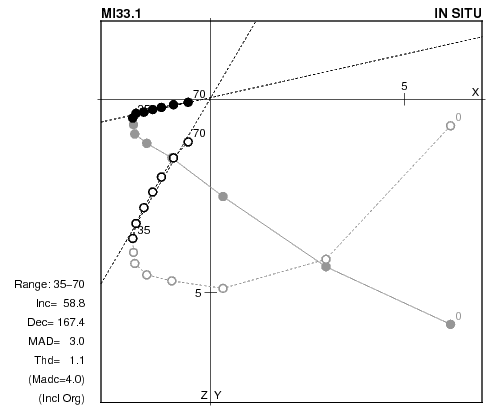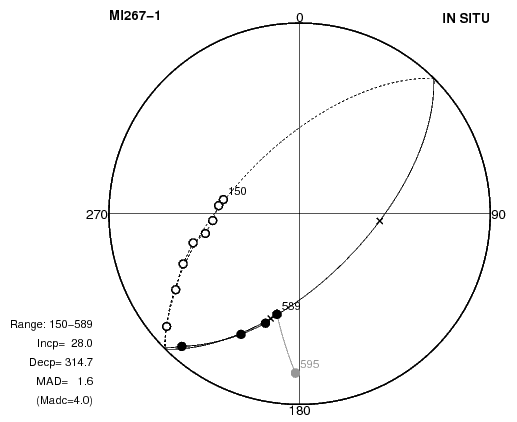 Paleodirections: Sample-level analysis; pdemag
Paleodirections: Sample-level analysis; pdemag
Program "pdemag" determines the sample-level remanence direction from the data of progressive demagnetization, which is the first stage of hierarchical analysis of paleomagnetic data. The program automatically seeks the remanence component in the highest range of blocking temperature (\(T_B\)) or coercive force (\(H_C\)), which is linear enough to give a maximum angular deviation (MAD) smaller than the critical MAD (MADc, default is 5°). The program uses a principal component analysis (PCA) which is simplified from Kirschvink (1980). An example of the line analysis by command L is shown below, in which the data is from the Proterozoic dolerite plug in Mount Isa, Australia (Tanaka & Idnurm, 1994).

When the result of line analysis is not satisfactory, there may be four ways to recalculate the data; (1) change MADc from the default value of 5° by command M, (2) exclude the origin from PCA by command R (default is to include the origin as an independent data point), (3) anchor the line to the origin by command A, and (4) turn off the automatic mode by command T and determines the line by manually.
PCA of plane is useful to the data which form a great circle (GTC) on the equal-area plot. Figure below shows an example of GTC analysis by command G, in which the sample is from the same dolerite plug shown above. In the plane PCA, only the directional information is used, i.e. each remanence is treated as a unit vector, and the plane is anchored to the origin. Manual analysis is also allowed.

Command W writes the results of line or GTC analyses to the user specified file which will be an input file to the next stage program "pdirec".
Download and installation of the program
References:
- Kirschvink, J.L., The least-squares line and plane and the analysis of paleomagnetic data, Geophys. J. R. astr. Soc., 62, 699-718, 1980.
- Tanaka, H., and M. Idnurm, Paleomagnetism of Proterozoic mafic intrusions and host rocks of the Mount Isa Inlier, Australia: Revisited, Precambrian Research, 69, 241-258, 1994. (→ doi:10.1016/0301-9268(94)90089-2)